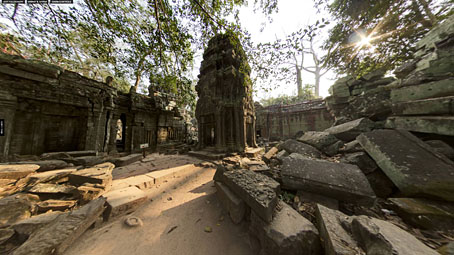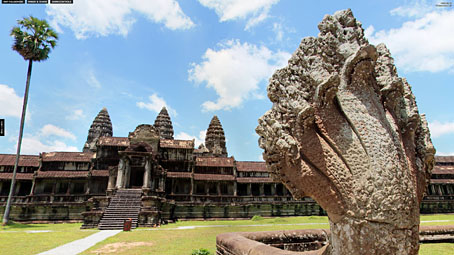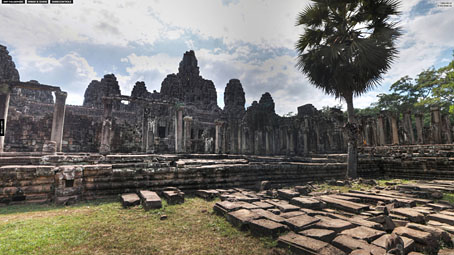Ta Phrom by Rob van Gils.
A Cambodian architecture post by Will from 50 Watts sent me to 360 Cities for some panoramic views of the temples of Angkor and environs. I always prefer the sight of these places in their weed-infested state even though all those weeds and tree roots were slowly destroying the stonework. For more recent photos, John McDermott’s site has many beautiful infra-red views of the temples and their statuary. (Click on the Fine Art section.)
Naga at Angkor Wat – Siem Riap, Cambodia by Tetsuyayoshi.jp.
Angkor by Vasiliy Nikitenko.
Elsewhere on { feuilleton }
• The panoramas archive
Previously on { feuilleton }
• The Temples of Bagan
• The temples of Angkor




I’d always thought that if one were seriously trying to make a presentable adaptation of something by Clark Ashton Smith, these ruins, again, in their overgrown state would have made the perfect place of dwelling and/or origin for one of the phantasmagoric beings that pull the strings of his protagonists, usually far more rogue-like and perhaps more three-dimensional than the more so allegorical protagonists employed by Lovecraft. CAS’s bestiary was also far more well-described and fleshed out.
In some ways I can see how Lovecraft is more popular, but its puzzling as to why Smith has been so overly ignored. Being that he was also interested in sculpture, Smith would have liked the depiction of Naga perched in front of the temple entrance.
I suppose any self-respecting Cambodian national may be somewhat confused or even offended, probably rightfully so, that I would take this beautiful architecture that once served as a beacon to surrounding nations when the Khmer empire bathed in glory, and turn it into something menacing and hostile. In my defense, I saw ‘Apocalypse Now’ at quite a young age for such a film. The last 45 or so minutes left an especially deep impression upon me, many of those scenes being set in and out of that vast and crumbling ancient, once-urban complex, now taken back by nature, or at least, during the time of filming, and often cast under brooding, rain-tinged nocturnal light.
This just makes me want to watch the movie again. I think I’ll hold off and visit the Panoramic site first though.
A few more added notes of interests, having looked at some of John McDermott’s pictures. I really like how certain examples of ancient Far Eastern architecture, most of them being in the Southest and the Himalayas, share strikingly familiar characteristics with surviving examples of ancient Native American architecture i.e. Mayan cities, and the few remaining examples of original Aztec and Andean constructions. One of the more recurrent ones being the similar style of non-curving arches used in many of the opening and hallways, as well as some of the traditional patterns used in the shape of many of the buildings’ foundations and the ways in which the first floors were constucted. With the buildings that begin to really reach up into the air, ones sees the similarities quickly fade at that point.
Also absolutely love the shots of the serpentine tree-roots inundating and devouring large swaths of architecture. I can understand why many of these have probably been removed, but damn they make for compelling pictures.
I agree entirely about the temples having a remote quality compared to what we’re used to seeing via the Classical or Gothic traditions. I made use of that with my collage piece depicting Yuggoth where engravings of Angkor appear in the bottom of the picture. As far as any cultural insult goes, in my defence I’ve done the same with British cathedrals for some of the Cradle of Filth illustrations, turning cloisters into Gothic tunnels.
I love the end of Apocalypse Now as much for that ruined temple as anything else, it actually makes the end of the film a lot more memorable than the end of Conrad’s story where Kurtz’s compound is merely another rundown outpost. Those watching stone faces in the film communicate some of the metaphysical anxiety which runs through the whole thing. I’ve had a copy of National Geographic for years that had a large feature on Angkor, some of it showing before and after shots of the overgrown ruins. Many of the temples had been unvisited for years so huge areas of jungle needed to be cleared before their extent could be fully appraised.
Hi John,
Do you have the book “GHOST SHIPS, A Surrealist Love Triangle” by Robert McNab?
It is about the relationship between Ernst, Gala and Eluard, they went to Cambodia in 1924.
It is very well illustrated with many interesting photos that make connections between the Cambodian temples and the paintings of Max Ernst like “The Stolen Mirror”, “The Entire City” series, the “Joie de Vivre” pictures and “The Eye of Silence”.
Hi Paul. No, I’d not heard about that book, and I don’t recall any mention of Ernst going to Cambodia either in the several books I have about his work or in the documentary film which came out a few years ago. (A quick look shows mentions of “a trip to the Far East” but nothing specific.) Thanks for the tip!